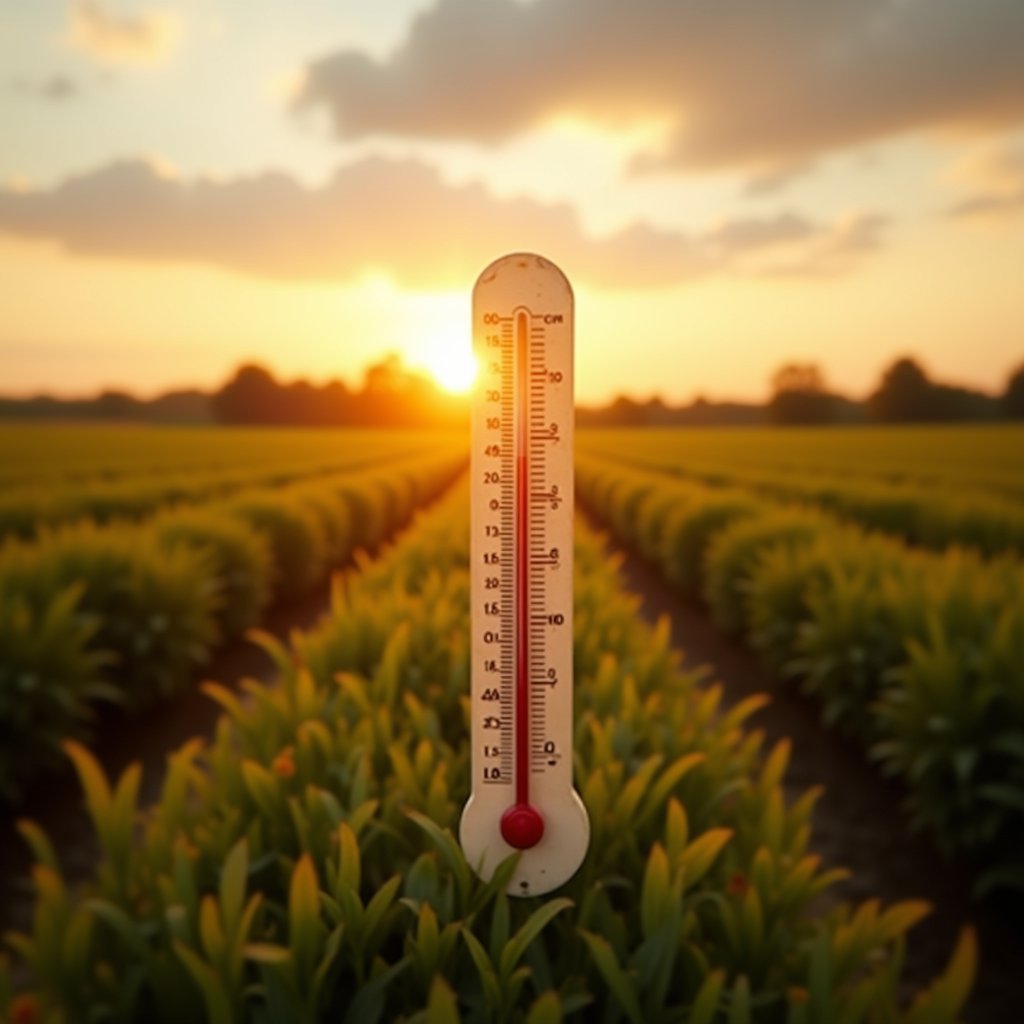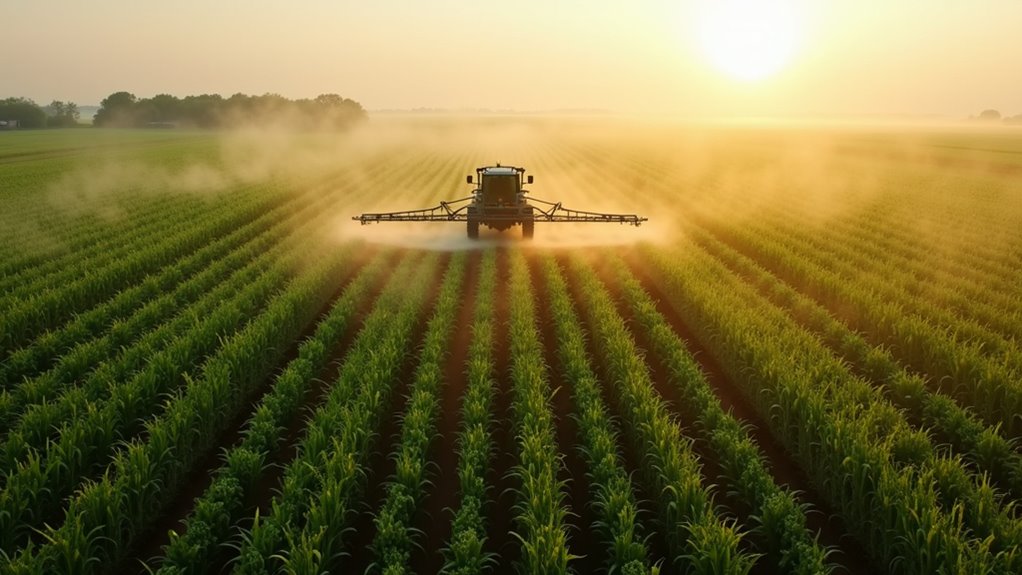Nitrous oxide’s devastating environmental impact has intensified in 2025, with atmospheric levels hitting 338.42 ppb a 40% surge since 1980. You’ll find N₂O acts as both a super-potent greenhouse gas (273 times stronger than CO₂) and the most significant ozone-depleting substance today. It’s driving accelerated climate change, breaking down protective ozone molecules, and threatening global temperature targets. Agricultural practices contribute over 65% of these emissions, but solutions exist through emerging precision farming techniques.
The Science Behind N₂O’s Warming Power

While many greenhouse gases contribute to global warming, nitrous oxide (N₂O) stands out with its remarkable warming potential of 310 times that of CO₂ over a 100-year period. The molecular dynamics of N₂O make it exceptionally efficient at trapping heat, as it absorbs infrared radiation at specific wavelengths that other greenhouse gases don’t capture.
The radiation absorption profiles of N₂O demonstrate why it’s the third most significant anthropogenic greenhouse gas, despite its lower atmospheric concentration. When you examine its warming efficiency, you’ll see it surpasses even methane in its ability to retain heat. What’s particularly concerning is that N₂O’s atmospheric stability allows it to persist for centuries, with limited natural removal mechanisms. With an estimated atmospheric lifetime of 120 years, N₂O’s presence in our atmosphere represents a long-term environmental challenge. Although it accounts for only 6% of greenhouse gas emissions, this combination of high warming potential and longevity makes it a critical driver of long-term climate change.
Agricultural Practices Driving N₂O Emissions

Your farm’s fertilizer and manure management decisions greatly influence global N₂O emissions, with synthetic fertilizers and anaerobic manure storage accounting for over 65% of agricultural nitrous oxide releases.
These emissions are measured in tonnes of CO₂-equivalents per person to standardize their climate impact assessment. According to international standards, all such emissions must undergo UNFCCC reporting to track compliance with climate agreements.
To minimize these emissions, you’ll need to implement precision agriculture techniques that match fertilizer application to crop demands and upgrade manure treatment systems to include aerobic storage or biogas capture capabilities. The data shows that combining these approaches can reduce your farm’s N₂O emissions by up to 40% while maintaining crop yields and livestock productivity.
Fertilizer Management Best Practices
Modern fertilizer management practices represent a vital frontier in reducing agricultural N₂O emissions through precision-driven approaches. Land stewardship methods now incorporate variable rate applications and band placement techniques, precisely matching nutrient delivery to soil fertility zones. Extension services consistently demonstrate that recommended application rates help farmers avoid costly over-fertilization while maintaining yields. You’ll find these nutrient cycling models optimize timing and placement through real-time soil sensors and IoT-driven systems. The integration of smart farming solutions has enabled a 20-30% reduction in fertilizer input costs through precision application technologies. Banding nutrients next to crop rows has become a preferred method for maximizing fertilizer efficiency while minimizing environmental impact.
Strategic timing plays an essential role in emission reduction. By delaying nitrogen application until post-planting and implementing split applications during key growth stages, you’re minimizing excess soil nitrogen prone to denitrification. Weather-responsive scheduling and sidedress timing sync with crop demand patterns. Combined with balanced NPK formulations and slow-release fertilizers, these practices maintain prime nutrient availability while substantially reducing N₂O release into the atmosphere.
Sustainable Manure Treatment Methods
Sustainable manure treatment has emerged as a critical intervention for reducing agricultural N₂O emissions in 2025. You’ll find that modern composting systems now integrate heat recovery for greenhouse operations while facilitating carbon sequestration through composting. These systems demonstrate significant potential for reducing fossil fuel dependency in cold climates while producing high-quality soil amendments. The development of two heating systems at UNH Woodman Farm showcases innovative approaches to sustainable manure management. Farmers are implementing integrated One Health solutions to ensure these practices protect human, animal, and environmental well-being simultaneously. New research initiatives are focused on developing scalable solutions that can be effectively implemented on farms of all sizes.
Anaerobic digestion for energy recovery has revolutionized manure management, particularly when combined with precision injection techniques in no-till systems. You’re able to amplify nitrogen availability while minimizing N₂O emissions through disk coulter injection methods. Research using mesocosm studies has improved our understanding of nitrogen dynamics during storage, leading to optimized practices that reduce greenhouse gas emissions while maintaining soil health and crop productivity.
Devastating Effects on the Ozone Layer

While chlorofluorocarbons (CFCs) once dominated concerns about ozone depletion, nitrous oxide (N₂O) has emerged as the most significant ozone-depleting substance in 2025, with 273 times the potency of CO₂. This shift presents an urgent environmental crisis as N₂O’s stratospheric ionization impacts accelerate ozone destruction at an unprecedented rate. Limited international controls under the Montreal Protocol have allowed N₂O emissions to continue largely unchecked. Ambitious action to reduce N₂O could provide ozone layer benefits comparable to five times those achieved by accelerating HCFC phase-out through 2100.
You’ll face intensifying UV-related human health concerns as N₂O continues to break down protective ozone molecules in the upper atmosphere. The compound’s destructive effects are amplified by its remarkable persistence, remaining active for over a century after emission. Without immediate intervention, we can expect higher UV levels to affect much of the global population. What makes this threat particularly challenging is that, unlike CFCs, N₂O emissions primarily stem from essential agricultural practices, making immediate reduction strategies complex and demanding creative solutions to protect both food security and atmospheric stability.
Global Health Consequences of N₂O
A staggering surge in nitrous oxide emissions has triggered cascading health consequences across global populations in 2025. You’ll find mortality rates climbing due to deteriorating air quality, with experts projecting up to 20 million preventable deaths by 2050 if emissions continue unchecked.
N₂O’s impact extends beyond respiratory issues, as CDC data shows a 110% increase in misuse-related deaths since 2019, affecting over 13 million Americans through recreational exposure. Social media platforms have made it easier for young people to access content showing nitrous oxide inhalation, contributing to increased misuse rates. Recent FDA warnings have highlighted that repeated exposure can cause severe medical complications including brain damage and paralysis.
The compound’s presence in agricultural practices has intensified water contamination risks, threatening rural communities’ health through contaminated groundwater. You’re also facing increased risks of heat-related illnesses as N₂O contributes to rising temperatures. These effects compound with widespread health burdens, including cardiovascular diseases, stroke risks, and compromised immune systems among exposed populations.
Current Emission Trends and Climate Goals
The latest atmospheric data shows N₂O concentrations reached a record 338.42 ppb in January 2025, marking a concerning 40% increase in anthropogenic emissions since 1980.
You’ll find this accelerating trend particularly troubling as N₂O emissions, primarily from agricultural sources, are now threatening the feasibility of meeting 1.5°C temperature targets. While the U.S. achieved a modest 3% reduction in emissions from 1990-2022, you’ll need to ponder that global N₂O levels continue rising due to expanding agricultural activities and insufficient nitrogen management policies.
Rising Global N₂O Levels
Global atmospheric nitrous oxide levels have reached an alarming 338.42 ppb in January 2025, marking a significant increase from 337.46 ppb just one year prior. You’ll notice this acceleration reflects growing challenges in controlling agricultural carbon footprint, with human activities now contributing over 10 million tons annually.
| Source Type | Impact Metrics |
|---|---|
| Agriculture | 60-80% of emissions |
| Natural Soils | 20% of total flux |
| Industrial | Rising yearly |
| Waste Management | Significant growth |
| Ocean/Fire | Minor contributors |
Emission monitoring challenges persist as N₂O’s 114-year atmospheric lifetime amplifies its warming effects. The post-2020 surge has pushed concentrations to unprecedented levels, with 2022 recording 336 ppb. This trajectory threatens climate goals, as N₂O’s impact is now 265 times more potent than CO₂ for global warming potential.
Temperature Goals at Risk
Current emission trajectories show that rising N₂O levels pose a critical threat to international temperature targets, with projections indicating we’ll exceed the 1.5°C pathway by 2030 if left unchecked.
You’ll find that rising emission trends are outpacing current mitigation scenarios, with N₂O now trapping 270 times more heat than CO₂ per tonne. This greenhouse gas accounts for roughly 10% of net global warming since the Industrial Revolution, making it the third most impactful after CO₂ and methane.
Climate mitigation challenges are intensifying as agricultural activities, primarily synthetic fertilizers and manure, contribute about 40% of global N₂O emissions. To meet temperature goals, you’ll need to reduce N₂O emissions by over 40% from current levels without these cuts, N₂O could add CO₂-equivalent emissions of 235 billion tonnes by 2100.
Agricultural Policy Changes
While agricultural emissions continue driving the 40% rise in global N₂O since 1980, emerging policy frameworks offer pathways to reduce these impacts through targeted interventions. You’ll find that improved nitrogen-use efficiency and carbon sequestration methods could prevent 235 billion tonnes of CO₂e by 2100, equivalent to six years of current fossil fuel emissions.
Nitrogen recycling initiatives and precision farming techniques are transforming agricultural practices, with potential emission reductions of 30-50% by 2050. You’re seeing new statistical models that enable site-specific predictions of N₂O emissions, allowing for more effective policy implementation. These tools, combined with amplified manure storage systems and sustainable farming practices, align with net-zero targets while protecting soil health, water resources, and food security goals.
Impact on Sustainable Development
Nitrous oxide emissions pose three critical challenges to sustainable development goals by threatening food security, public health, and environmental stability. You’ll find these emissions directly undermining global efforts in the direction of sustainable material recycling and ecosystem restoration strategies, as they contribute 270 times more warming potential than CO₂.
The impact extends beyond climate effects, as N₂O emissions jeopardize your communities’ progress toward multiple UN Sustainable Development Goals. They’re compromising food security by disrupting agricultural systems, while simultaneously threatening public health through increased UV exposure and air pollution. Current trajectories suggest these emissions could cause up to 20 million premature deaths by 2050.
Furthermore, N₂O’s role in water pollution and biodiversity loss creates a complex web of environmental challenges that’ll require integrated solutions to protect both human wellbeing and ecological balance.
Strategies for Reducing N₂O in Farming
Modern precision agriculture lets you reduce N₂O emissions by up to 25% through data-driven fertilizer applications and improved basalt weathering techniques that maximize nitrogen uptake.
You’ll achieve significant emissions reductions by implementing strategic crop rotations, as demonstrated by the 9-fold decrease in N₂O when switching from continuous corn to soybean rotations at the Villa Grove site.
Your manure management systems can further minimize N₂O release through aerobic composting, covered storage facilities, and timing applications during ideal soil conditions.
Precision Fertilizer Application Methods
As agricultural technology advances, precision fertilizer application methods have emerged as crucial strategies for reducing N₂O emissions in farming operations. You’ll find that side-dressing techniques near root zones can reduce emissions by 15-20% compared to broadcasting, while enhancing soil health improvements through targeted nutrient delivery.
Modern carbon capture techniques benefit from precision placement strategies like band application in canola and wheat, which greatly reduces nitrate leaching. You can achieve excellent results by implementing variable rate technology that adjusts N application based on real-time soil data. By adopting guidance systems for targeted delivery, you’ll cut N use by approximately 22 lb/acre without compromising yields. This precision approach, combined with soil variability mapping, guarantees economic efficiency while minimizing your farm’s environmental impact through reduced N₂O emissions.
Crop Rotation Benefits
While traditional monoculture systems contribute heavily to N₂O emissions, implementing diversified crop rotations can reduce these emissions by up to 39% through strategic sequencing of high-residue and legume phases. You’ll achieve ideal nutrient recycling optimization by incorporating sweet potatoes or peanuts into your rotation, breaking continuous cereal nitrogen cycles.
To maximize these benefits, you’ll want to position legumes in non-corn phases of your rotation, avoiding overlapping high-N periods that can spike emissions. This approach supports integrated weed management while improving soil microbial activity. When you design your three-year rotations (corn-soybean-grain), focus on the corn phase as your primary emission point requiring targeted mitigation strategies. Regional adaptations, such as North China Plain models, demonstrate how you can balance yield potential with N₂O reduction goals.
Advanced Manure Management Systems
Advanced manure management systems represent a critical frontier in N₂O emission reduction, with precision technologies delivering up to 40% lower nitrogen losses compared to conventional methods. Modern nutrient accounting systems integrate GPS-guided spreaders with real-time soil analytics, ideal/suitable application rates while ensuring regulatory compliance.
Key manure storage improvements and distribution innovations include:
- Anaerobic digesters that capture methane while stabilizing nitrogen content
- Deep injection systems paired with drag hoses for precise underground application
- IoT-enabled soil sensors monitoring nitrogen levels continuously
- Variable-rate applicators adjusting nutrient delivery based on crop demand
- Pipeline networks minimizing soil compaction and nutrient loss during transport
These technologies, combined with predictive analytics and weather-responsive adjustments, create a thorough/extensive framework for reducing N₂O emissions while maintaining optimal crop yields.
Environmental Justice and N₂O Pollution
The intersection of environmental justice and nitrous oxide pollution reveals stark disparities in health impacts and exposure risks across global populations. You’ll find that marginalized communities near agricultural sites face disproportionate exposure to N₂O emissions, with projections indicating up to 20 million premature deaths by 2050. Limited community resilience and public health monitoring in these areas compound the crisis.
Low-income regions experience multiple burdens: they’re often situated near industrial farms, lack adequate healthcare infrastructure, and face heightened UV exposure from ozone depletion. The data shows that 40% of global N₂O emissions come from agriculture, concentrated in food-insecure areas. These communities also struggle with overlapping challenges, including biodiversity loss and water scarcity, while lacking resources for thorough N₂O monitoring and mitigation strategies.
Economic Costs of Unchecked N₂O Emissions
Beyond environmental justice concerns, unchecked N₂O emissions carry staggering economic implications that ripple through global markets and regulatory frameworks. You’ll find compliance costs soaring to $1.1 billion by 2026 in the U.S. cement industry alone, while regulatory uncertainty creates challenges for long-term investment planning. The social cost of N₂O emissions stands at $5,400 per metric ton, vitally higher than both CO₂ and methane.
Key economic impacts you need to ponder:
- Cement manufacturers facing billion-dollar compliance costs
- Transportation sector bearing stricter emission standards
- Agricultural processes requiring costly mitigation measures
- Global competitiveness risks when domestic industries face tighter controls
- Supply chain disruptions from climate-related extreme weather events
The dynamic discount rates and shifting regulatory policies further complicate cost projections, making immediate action pivotal for economic stability.
Policy Solutions and International Action
Since global efforts to combat climate change have intensified, international policy frameworks now recognize N₂O as a fundamental target for emission reduction strategies. You’ll find that COP29’s launch of the 2024 UN Global N₂O Assessment has established a clear pathway to achieve a 40% reduction in emissions through multi-stakeholder collaboration.
The Montreal Protocol’s alignment with climate goals now prioritizes N₂O mitigation, as it’s become the dominant ozone-depleting substance. You’re seeing increased focus on financing mitigation efforts, particularly in agricultural sectors where improved nitrogen-use efficiency and technological innovation are pivotal. International partnerships between UNEP and SEI are scaling up implementation of monitoring tools, while standardized emission reporting frameworks help track progress toward both climate and ozone protection goals.
Frequently Asked Questions
How Does Nitrous Oxide Compare to Other Greenhouse Gases in Oceans?
When you compare N₂O to other greenhouse gases in oceans, you’ll find it’s remarkably potent – 265 times more powerful than CO₂ and considerably stronger than methane.
Ocean acidification effects are intensified as N₂ O interacts with marine systems, while nitrogen cycle disruption occurs through increased eutrophication.
You’ll notice that oceans contribute 50% of natural N₂O emissions, making them equal to human-driven sources in global impact.
Can Indoor Plants Help Reduce Nitrous Oxide Levels in Homes?
While indoor plants excel at carbon dioxide absorption and filtering certain pollutants, there’s limited evidence they can markedly reduce indoor N₂O levels. You’ll find their air purification effectiveness varies by species, but studies show they’re more successful with VOCs and CO₂ than N₂O.
Your best approach is combining plants with proper ventilation and minimizing nitrogen-rich fertilizers, as direct N₂O removal by plants hasn’t been conclusively demonstrated in residential settings.
Does Nitrous Oxide From Dental Procedures Contribute Significantly to Environmental Damage?
While dental procedures use N₂O as an anesthetic, you’ll find there’s currently limited data quantifying their specific environmental impact. Dental waste disposal and anesthetic gas regulations vary by region, making it challenging to assess the sector’s total contribution.
Unlike agricultural sources that account for the majority of N₂O emissions, dental procedures aren’t highlighted in recent UNEP assessments as significant contributors. You’ll need more thorough/detailed/extensive studies to determine their exact environmental footprint.
How Do Volcanic Eruptions Affect Global Nitrous Oxide Concentrations?
While volcanic eruptions emit nitrogen oxides (NOx), you’ll find they don’t substantially increase global atmospheric nitrous oxide buildup.
Current volcanic activity levels primarily release NOx that converts to N2O5 through stratospheric chemistry, rather than directly contributing to N2O concentrations. Instead, the NOx emissions participate in complex chemical processes involving hydrolysis and ozone interactions. Anthropogenic sources remain the dominant driver of global N2O levels in the atmosphere.
What Role Do Forests Play in Naturally Absorbing Nitrous Oxide?
You’ll find that research on forests’ role in nitrous oxide absorption remains limited and uncertain.
While forests contribute to ecosystem carbon sequestration, their specific impact on vegetation nitrous oxide uptake isn’t well documented. Unlike CO2, where forests act as clear carbon sinks, their N2O absorption capacity hasn’t been conclusively established in scientific literature.
Current evidence suggests forests may play a minor role in N2O uptake compared to their carbon sequestration abilities.






